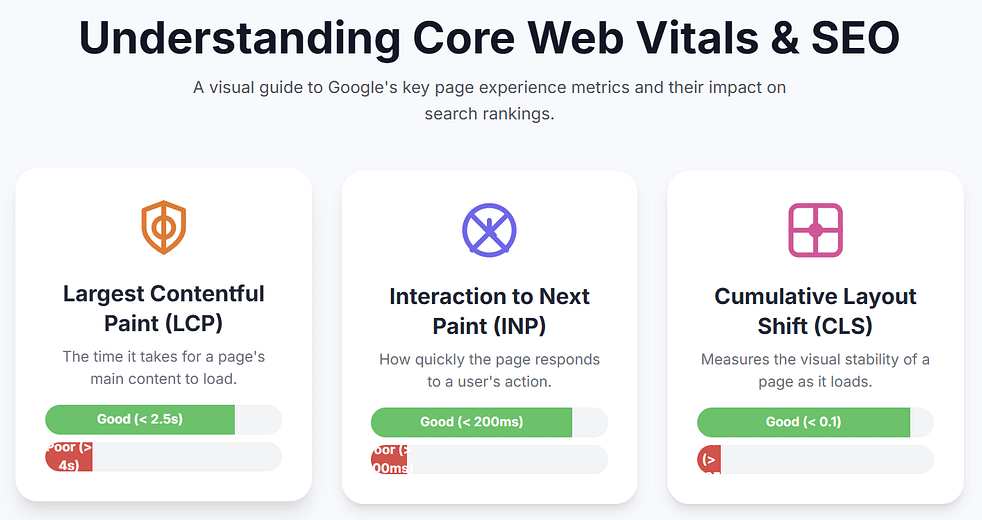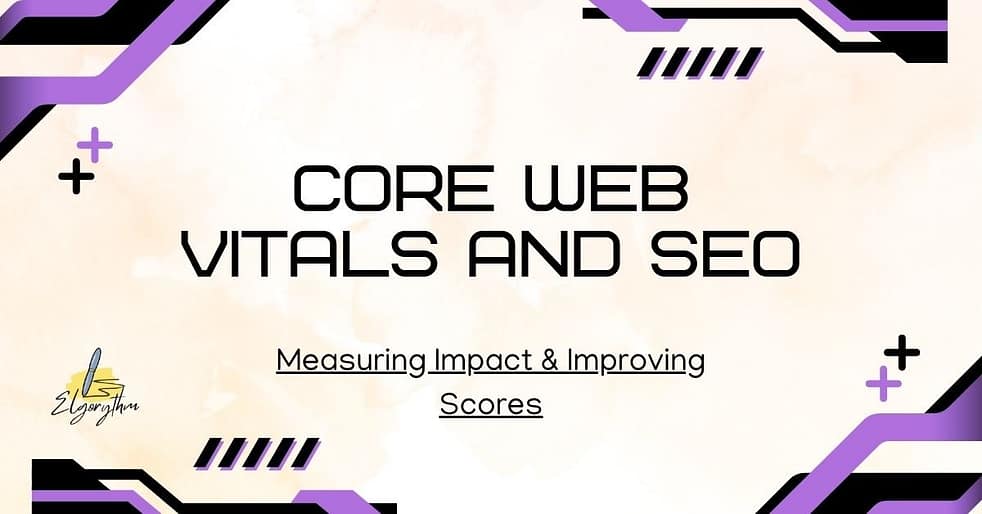Search engine optimization isn’t just about keywords and links anymore – Google now cares about user experience. It introduced Core Web Vitals, a set of page speed and stability metrics that feed into its Page Experience ranking factor. But what exactly are these metrics, and why do they matter? We’ll answer “What are Core Web Vitals” in plain terms, explain their SEO impact, share real statistics on speed, and show how you can measure and boost these scores.
What are Core Web Vitals?
Many people ask, “What are Core Web Vitals?” Simply put, they are three key measurements that capture real users’ experience of your site’s speed and stability. Specifically:
- LCP (Largest Contentful Paint): How long it takes for the main content (like a big image or headline text) to appear. Aim for < 2.5 seconds. A fast LCP means users see helpful content quickly; a slow LCP (4+ seconds) usually drives people away.
- INP (Interaction to Next Paint): (Replaced FID in 2024) How quickly the page responds to your first interaction (such as clicking a button). Aim for < 200 ms. A low INP feels snappy; a high INP feels sluggish and unresponsive.
- CLS (Cumulative Layout Shift): How stable the page layout is as it loads. If images or ads jump around and push content unexpectedly, the CLS score rises. Aim for < 0.1. Low CLS means the page doesn’t shift much – a much smoother experience.
In a nutshell, Core Web Vitals measure loading speed, interactivity, and visual stability from a user’s perspective. Google recommends all three metrics be “good” (green). Failing any one is like failing an important user-experience test.
Why does this matter? User behavior shows page speed is crucial: surveys find about half of users expect a page to load within 2 seconds, and roughly 40% will abandon it if it takes longer than 3 seconds. Fast LCP and low INP help meet those expectations, and a low CLS prevents annoying jumps that make people mis-click. In other words, What are Core Web Vitals? They’re Google’s way of quantifying page performance, and optimizing them is now central to a good SEO strategy.

Core Web Vitals SEO and Rankings
So how do Core Web Vitals tie into SEO? Google has officially incorporated them into its ranking signals. In practice, think of Core Web Vitals as a tie-breaker. If two pages have equally great content, the one with better Core Web Vitals – i.e. faster load and smoother experience – will likely rank higher. Good Core Web Vitals SEO simply means optimizing for these metrics.
It’s important to note: relevant content still matters most. An awesome article can rank well even with mediocre vitals. However, among similarly relevant pages, the faster, more stable one gains the edge. Real-world stats back this up: one retailer saw about a 7% increase in conversions by speeding up their pages by under 1 second. Even a tiny boost (0.1 second) can yield roughly 1% more conversions on some sites. Amazon famously found every extra 100 ms of delay cost them ~1% in sales. These figures show that better Core Web Vitals often mean real business gains – lower bounce rates and higher engagement – which Google rewards.
Remember: Core Web Vitals come from real-user (field) data, not lab tests. Google Search Console’s Core Web Vitals report shows how your actual visitors experience your pages. Only those real-world scores affect rankings. (Tools like Lighthouse or PageSpeed Insights give useful advice, but their “scores” don’t directly change your SEO.) In short, focus on improving what real visitors feel and see.
One way to understand Google’s approach is its Page Experience ranking factor. In mid-2021 Google rolled out this update, which bundles Core Web Vitals with four other signals: mobile-friendliness, HTTPS security, safe browsing, and no intrusive interstitials (pop-ups). Together these five signals make up the Page Experience ranking factor. Core Web Vitals are the new, user-centric part of it. The message is: your site should be fast, secure, mobile-friendly, and not annoying (no full-page ads).
Importantly, Google says content relevance still outranks all UX signals. But if two pages have equally great content, page experience decides who wins. For example, say two pages have the same helpful article. If one loads instantly with no layout shifts and the other loads slowly with shifting elements, Google’s page experience ranking factor will favor the first site.

Measuring and Improving Core Web Vitals
Now for the practical part: how do you measure and improve your Core Web Vitals scores?
Measuring: Google provides tools. Check the Core Web Vitals report in Search Console – it shows how many URLs on your site are Good, Needs Improvement, or Poor for LCP, INP, and CLS (based on Chrome users’ data). You can also use Google PageSpeed Insights for specific URLs; it displays both lab and field data (remember only the field data drives SEO). Other tools like Lighthouse, WebPageTest, or the Chrome User Experience Report (CrUX) can help diagnose issues.
Improving: Focus on optimizing speed and stability. Here are common tactics (essentially Core Web Vitals SEO best practices):
- Optimize Images & Media: Compress large images and serve them in modern formats (WebP/AVIF). Use lazy-loading for images below the fold. Preload your key “hero” image so it starts loading immediately. Smaller, efficiently-delivered images dramatically reduce LCP.
- Minimize Code Blocking: Remove or defer non-essential JavaScript and CSS. Inline critical styles so content appears faster. Unused JS/CSS just slows everything down – every bit you trim makes LCP and INP faster. Tools like Chrome’s Coverage report can find unused code.
- Use Caching & CDN: Enable browser and server caching so repeat visitors load cached assets instantly. Use a Content Delivery Network to serve files from servers close to users. Even switching to a faster hosting service can improve scores significantly, especially for first-time visitors.
- Set Dimensions & Prevent Shifts: Always include width and height on images/videos so the browser allocates space. Reserve space for ads or embeds. This prevents layout shifts as content loads, keeping CLS low.
- Limit Third-Party Scripts: Third-party widgets (social buttons, ads, chatbots, etc.) often cause long loading and layout shifts. Remove any you don’t need, and load the rest asynchronously or after main content.
- Preload Key Resources: Use <link rel=”preload”> for critical assets like fonts or above-the-fold images so the browser fetches them first. This small step can improve LCP.
- Monitor Continuously: Check your Core Web Vitals in Search Console regularly. After any site update, retest your pages with PageSpeed Insights or Lighthouse. Keeping tabs on your scores ensures that changes (like adding a new plugin or banner) don’t break your performance.

Core Web Vitals SEO isn’t magic – it’s just good user-centric optimization. Implementing these steps will steadily raise your scores. A faster, more stable page not only makes Google happier, but also keeps visitors engaged (and converting).
In summary, what are Core Web Vitals? They are the key speed and stability metrics Google cares about, now part of the Page Experience ranking factor. Focusing on Core Web Vitals SEO means tuning your site so LCP, INP, and CLS are in the green. As you improve these scores, you’ll likely see better rankings when content is similar, happier users, and potentially higher conversions.
FAQs
- What are Core Web Vitals?
Core Web Vitals are Google’s three main page experience metrics: LCP (Largest Contentful Paint for loading speed), INP (Interaction to Next Paint for interactivity), and CLS (Cumulative Layout Shift for visual stability). They measure how fast the main content loads, how responsive the page is, and how stable the layout is. Optimizing them makes your site feel faster and smoother for visitors.
- How do Core Web Vitals affect SEO?
They are part of Google’s page experience signals. While great content remains top priority, pages with better Core Web Vitals have an advantage in search rankings when competitors’ content is similar. In other words, good Core Web Vitals can break ties and help boost your SEO.
- What is a good Core Web Vitals score?
Google recommends LCP < 2.5s, INP < 200ms, and CLS < 0.1 for a “good” score. Pages meeting all these are considered user-friendly. If any metric is above those thresholds, it signals an experience issue that should be fixed.
- How do I measure my Core Web Vitals?
Use Google Search Console’s Core Web Vitals report to see real-user data for your pages. You can also run PageSpeed Insights or Lighthouse on individual URLs; they’ll report LCP, INP (FID), and CLS values and often suggest fixes. Regular monitoring after site changes is key to keeping scores high.
- How do I improve my Core Web Vitals?
Common fixes include compressing and properly sizing images, preloading important assets, minimizing and deferring JavaScript, using caching/CDNs, and reserving space to prevent layout shifts. These optimizations speed up loading (improving LCP/INP) and stabilize layouts (improving CLS). Small improvements to these areas can make a big difference in both user satisfaction and search rankings.
- What is the Page Experience ranking factor?
It’s Google’s update that combines Core Web Vitals with other UX signals (mobile-friendliness, HTTPS, safe browsing, no intrusive pop-ups) into one ranking factor. A website that excels in all these areas is said to have a great “page experience.” Optimizing for Core Web Vitals is a core part of ensuring your site succeeds under this Page Experience ranking factor.




